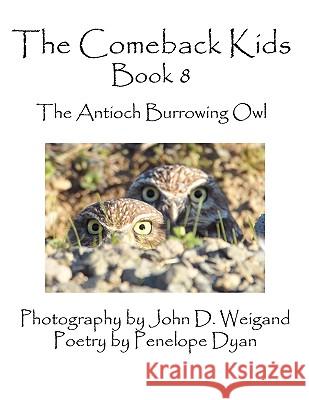The Comeback Kids, Book 8, the Antioch Burrowing Owl » książka
The Comeback Kids, Book 8, the Antioch Burrowing Owl
ISBN-13: 9781935118862 / Angielski / Miękka / 2009 / 60 str.
The burrowing owl(Athene cunicularia)is federally protected by the Migratory Bird Treaty Act in the U.S. and Mexico, and is listed as endangered, threatened, or as a Species of Concern in nine states, including California, where it is considered a Species of Special Concern by the California Department of Fish and Game. No one is supposed to do anything that could destroy a burrow. You must not cover a burrow with dirt, because you could kill an owl inside of it. The Burrowing Owls' population is declining. Nesting sites are being lost to development. Unlike birds that nest in trees, the Burrowing Owl is dependent on ground burrows dug by other animals, such as the ground squirrel, as you will see in this book. It is how all things work together for good. The Burrowing Owl is most active during the day. And kids can easily watch them interact with the environment, unless they frighten the owls away. This lends itself to a great educational experience for them. The author and photographer of this book traveled to Antioch, California, near San Francisco, to capture pictures of them in a habitat that is being encroached upon by development. Yet, in spite of this, the burrowing owl has continued to survive; and it is the hope of the author and photographer they will continue to do so. The Burrowing Owl is very small, only about 7 1/2 - 10 inches tall. It has a a wingspan of about 21 - 24 inches, and weighs only 4 1/2 - 9 ounces. The male is slightly heavier and has a longer wingspan than the female, unlike in other birds. Burrowing Owls feed on insects and small mammals, and sometimes reptiles and amphibians. They hunt as they walk or run or swoop down from above, and they catch insects as they fly through the air. The greatest threat to burrowing owls is habitat destruction and degradation caused by land development, despite their protected status. The natural life span of the Burrowing Owl is 6-8 years, if not threatened, displaced, removed or killed. Once again, enjoy the photography of John D. Weigand and the poetry of Penelope Dyan, as you see how the borrowing owls made their comeback in Antioch by nesting among abandoned construction. The sad thing is construction was only abandoned because of the downturn in the economy, not to protect the owls; and it is expected to resume. This why it is important to get out the word about these entertaining little creatures before it it too late. Protected species should be just that, protected; and these tiny 'Comeback Kids' do deserve to stay where they are Everyone needs to learn to live with nature and become one with it, or we will merely put ourselves in peril. This is yet another Bellissima book meant for kids that looks just great on your coffee table, and delivers a great big message, this time about a very little and very important, beneficial bird.











